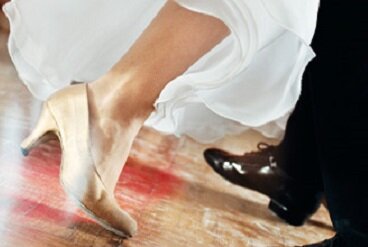Tango Heel Close 
9 November 2016
To the countless dancers who despise the Heel Turn and curse its very existence, Tango is your dance. While Heel Turns are integral to Foxtrot, and even Waltz and Quickstep make use of them within the Syllabus, Tango has done away with them entirely in favour of a much easier technique called the Heel Close. This article will introduce you to the Heel Close, how to dance it, how to lead it, and the Tango figures it is used in.
How to Dance It
The Heel Close is a different method of achieving the same result as the Heel Turn (for secrets on the Heel Turn, click here). The end result is to close the feet, and step in place facing a new alignment, but take a look at how these two techniques work.
| Heel Turn | Heel Close | ||
| 1 | RF back, backing DC | RF back, backing DC | |
| 2 | Draw LF toward RF until closed | ||
| 3 | Turn on heel, then transfer weight to LF (HT), end facing LOD | Close Left Heel to Right Heel (WF), LF pointing LOD |
The first difference is that part 2 of the Heel Turn is entirely missing. This is because in Foxtrot, halfway through the step the feet are drawn past each other (see this article on Standard Walks), whereas weight is transferred more slowly in Tango, and feet are picked up between steps, so this action is totally omitted.
The second difference is that the footwork on part 3 is Heel Toe for the Heel Turn, but Whole Foot for the Heel Close. The reason the step for the Heel Turn is HT is because the turn was done on the heel, so the next step must start on the heel as weight rolls from the back of the foot to the front. After coming onto the heel, there is a typical push off the ball of the foot, which is where the Toe part of the HT comes in. In Tango, the entire foot is placed flat and in place, because it isn't coming from having turned on the heel, as in the Heel Turn. Also in Tango, there isn't the same pushing action forward from the ball of the foot as in Foxtrot (which is why the footwork for Tango Forward Walks is H, while in Foxtrot it is HT), so there is no need to end the footwork with the Toe.

The third difference is that the Heel Turn ends facing LOD, while the Heel Close ends pointing LOD. This is because in the Heel Turn, the balls of the feet are closed, and both feet end up pointing down LOD together along with the body, but in the Heel Close, the RF is unaffected, and the LF closes to it pointing down the LOD while the RF remains pointing DW against LOD, with the body somewhere between them.
How to Lead It
In other dances, one main aspect of leading the Heel Turn is the concept of Early Rise, but there is no rise and fall in Tango. Instead, the Heel Close relies entirely on body placement. The first step is normal (LF forward), but for the second step, the Man may imagine the Lady as a pole, anchored in the ground. His second step must be taken around that step, without moving that pole. If he steps too far away from the Lady, he will force the Lady either to take a step and not close her feet, or to close her feet but be off balance, with her upper body falling toward the Man. If the Lady feels either of these things, then it means that the Man is disturbing her balance, and not stepping around her as if she were a poll.
If the second step is taken without disturbing the Lady's balance, she will end up taking her step direction beneath herself, which will be a Heel Close. It's as simple as that!
Figures that Use It
The most common place to see the Heel Close is in the Telemark to PP, or steps 1-3 of the Oversway. This is one of the most popular Gold figures, and these steps are used in many Open figures, even in Professional routines, such as the Telespin and the Double Reverse Spin.